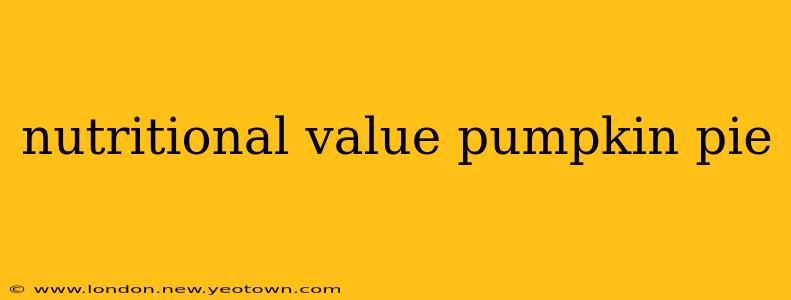Ah, pumpkin pie! The quintessential dessert of autumn, a comforting classic that graces Thanksgiving tables and cozy fall evenings alike. But beyond its delightful taste and warm spices, what's the real nutritional story behind this beloved treat? Let's delve into the nutritional value of pumpkin pie, separating fact from fiction and exploring how to enjoy this seasonal indulgence responsibly.
What is the nutritional content of a slice of pumpkin pie?
This depends heavily on the recipe! A typical slice of homemade pumpkin pie, about 300 grams, might pack around 350-450 calories. This calorie count can fluctuate significantly depending on factors like the type of crust used (graham cracker, pastry, etc.), the amount of added sugar, and the inclusion of other ingredients. A slice of store-bought pumpkin pie tends to be higher in calories and fat than a homemade version. The nutritional breakdown usually includes carbohydrates (primarily from sugar and the crust), some protein (primarily from the pumpkin puree), and varying amounts of fat (depending again on the crust and added ingredients).
Is pumpkin pie healthy?
The straightforward answer is: it depends. Pumpkin itself is a nutritional powerhouse, boasting Vitamin A, fiber, and potassium. However, the added sugars, fats from the crust, and often generous additions of cream or whipped topping significantly alter the overall nutritional profile. A small slice, enjoyed occasionally as part of a balanced diet, isn't likely to cause harm. However, regularly consuming large portions of pumpkin pie can contribute to weight gain and other health concerns related to high sugar and fat intake.
How many calories are in a slice of pumpkin pie?
As mentioned earlier, a typical slice can range from 350 to 450 calories, and this is just an estimate. It's crucial to check the nutritional information on the pie's packaging if it's store-bought or calculate the calories based on your specific recipe if it's homemade. Websites and apps dedicated to nutritional information can be helpful tools for calculating the nutritional content of your homemade pumpkin pie based on the ingredients you use.
What are the benefits of eating pumpkin pie? (In moderation!)
While not a health food in large quantities, pumpkin pie does offer some benefits when consumed in moderation:
- Vitamin A: Pumpkin puree is an excellent source of beta-carotene, which your body converts to Vitamin A, crucial for eye health, immune function, and cell growth.
- Fiber: Pumpkin provides dietary fiber, aiding digestion and promoting feelings of fullness. This can be helpful in managing weight and preventing constipation.
- Potassium: Pumpkin is a decent source of potassium, an essential mineral for maintaining healthy blood pressure.
How can I make a healthier pumpkin pie?
The beauty of homemade pumpkin pie lies in the ability to control the ingredients! Consider these healthier options:
- Reduce sugar: Use less sugar in your recipe or explore alternatives like maple syrup or honey (always in moderation).
- Whole wheat crust: Opt for a whole wheat crust instead of a traditional pastry crust to boost fiber content. You could even try a gluten-free crust for those with dietary restrictions.
- Reduce fat: Use less butter or oil in the crust and consider using Greek yogurt or applesauce as a partial substitute for some of the fat in the filling.
- Portion control: This is crucial! Enjoy a smaller slice and savor every bite.
Ultimately, pumpkin pie is a delicious seasonal treat best enjoyed in moderation. By understanding its nutritional content and making informed choices about ingredients and portion sizes, you can savor the flavors of fall without compromising your health. Remember, balance is key to a healthy and enjoyable lifestyle!

